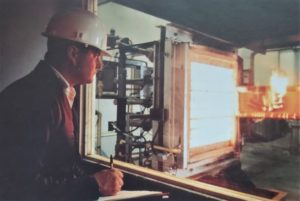 Guidance on Performance of Paint finishes in Standard Tests
Guidance on Performance of Paint finishes in Standard Tests
- Paint systems cannot be tested in isolation; they must be tested as they will be used in practice applied to a representative substrate.
- Test results can vary dependent upon the nature of the substrate to which they are applied. If paint is applied to a timber substrate, for example, it is likely to give a worse performance than if it is applied to a plasterboard substrate.
- It is not possible to generalise substrates as ‘combustible’ or ‘non-combustible’. A test result on a steel substrate, for example, may be worse than on a plasterboard substrate because Delamination of the coating from the steel occurs. Conversely a better result may be obtained on the steel substrate because it has different thermal characteristics than the plasterboard. Generalisations are dangerous.
Small differences in substrates can significantly affect the test results; the thermal conductivity, specific heat and density of the substrate all influence the test performance. A thinner steel substrate, for example, could give worse results than a slightly thicker steel substrate. With combustible substrates thicker substrates tend to give an improved performance during the early stages of the test due to increased thermal capacity) but poorer performances during
- the later stages due to additional fuel availability.
- The preparation of the substrate (e.g. cleaning, primer, undercoat systems) can affect the test results. The degree of adhesion of the coating system under the test conditions can be very important.
- The thickness of the coatings can be significant. In general the thicker the coatings the worse the result, but again generalisations can be dangerous.
- Apparently minor variations such as colour, method of application, time between application of coats and temperature/humidity conditions during the application process can all affect the test results.The development of a meaningful test programme to give the widest possible information on the paint system is therefore vital. Control of the application process is also important to ensure that the coating systems applied in practice are as similar as possible to the situation which was tested.
- Previously Painted SurfacesIt is not possible to confidently predict the spread of flame and heat release properties of coatings applied to previously painted surfaces. The existing paint finishes may be old and the effectiveness of their adhesion to the substrate or between coatings may be poor. In general, existing gloss paint systems tend to be the greatest problem and this is influenced by miniscule deposits of dirt which are difficult to remove, even by thorough washing. These cause trapped air layers which can lead to insulation/delamination problems. The combination of gloss and emulsion systems can also lead to poor performance, underlying emulsion coatings acting as an insulating layer. On the other hand it is possible that the properties of the old paints may have improved with ageing. Some paint manufacturers have conducted series of tests to investigate the properties of multi-coat systems, usually with modern paint formulations and these are usually accepted by specifiers as satisfactory evidence. The only way, however, is to remove all previous coatings and apply new systems to the stripped substrate.